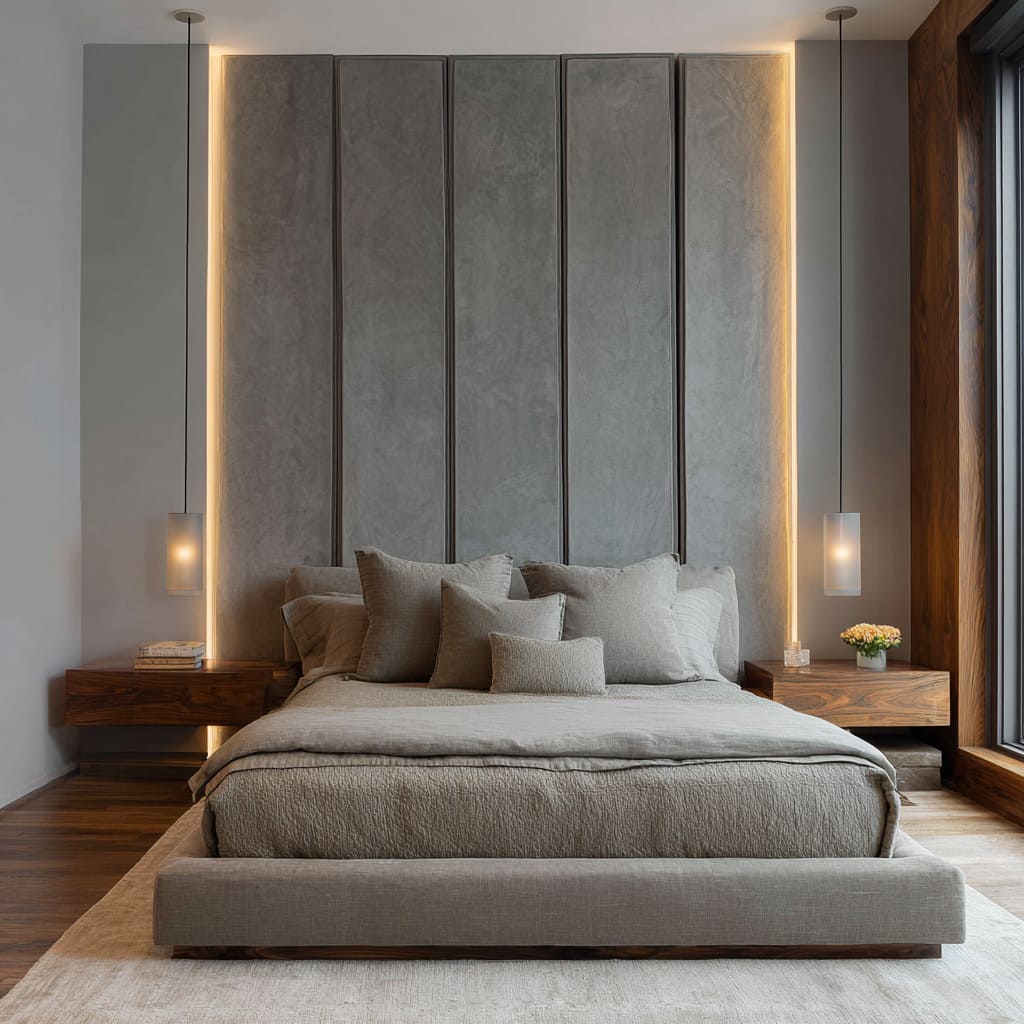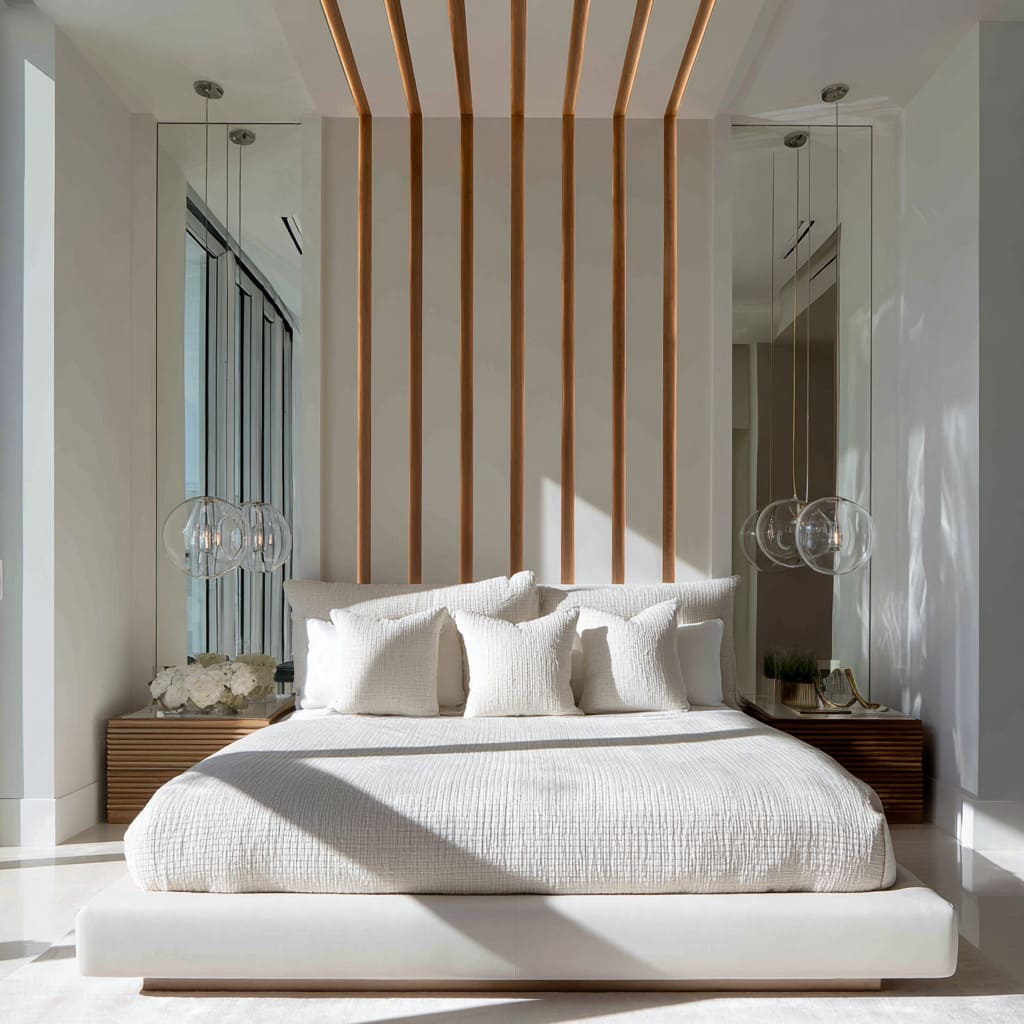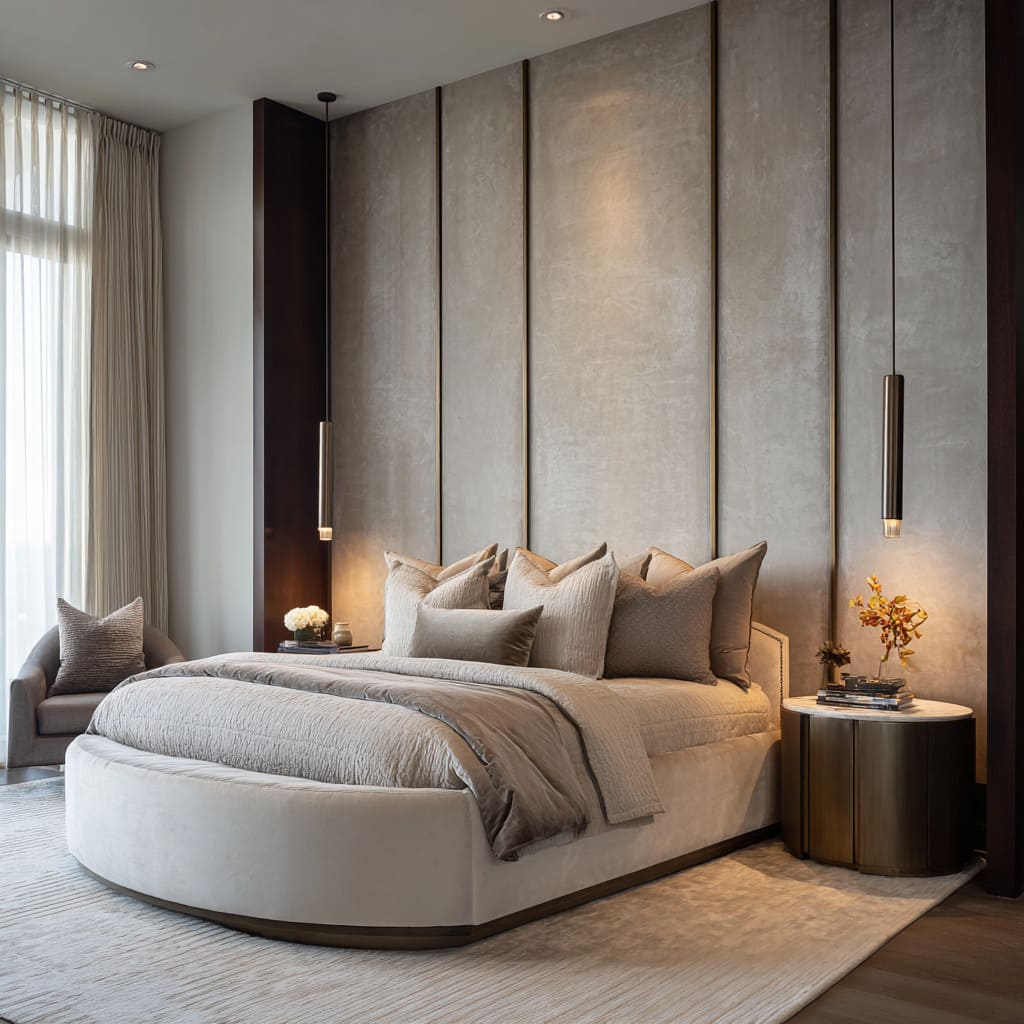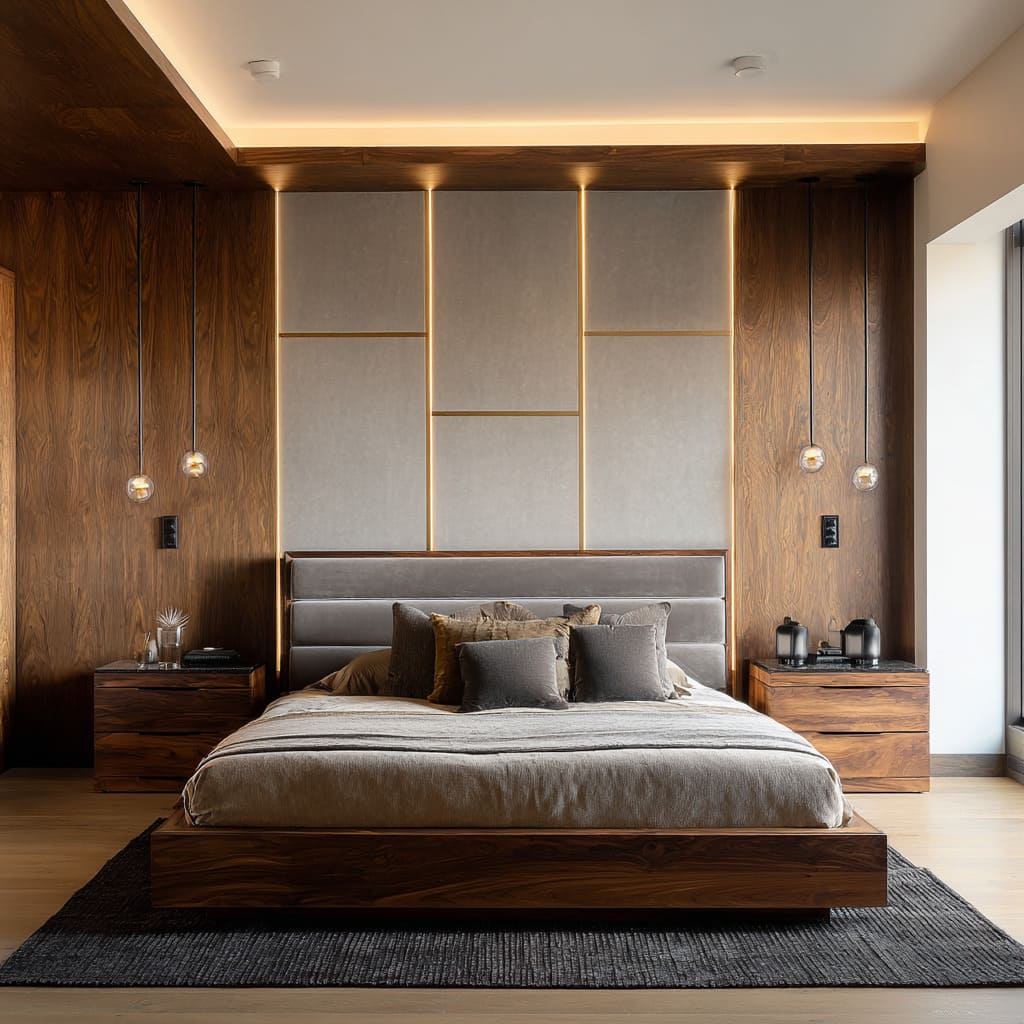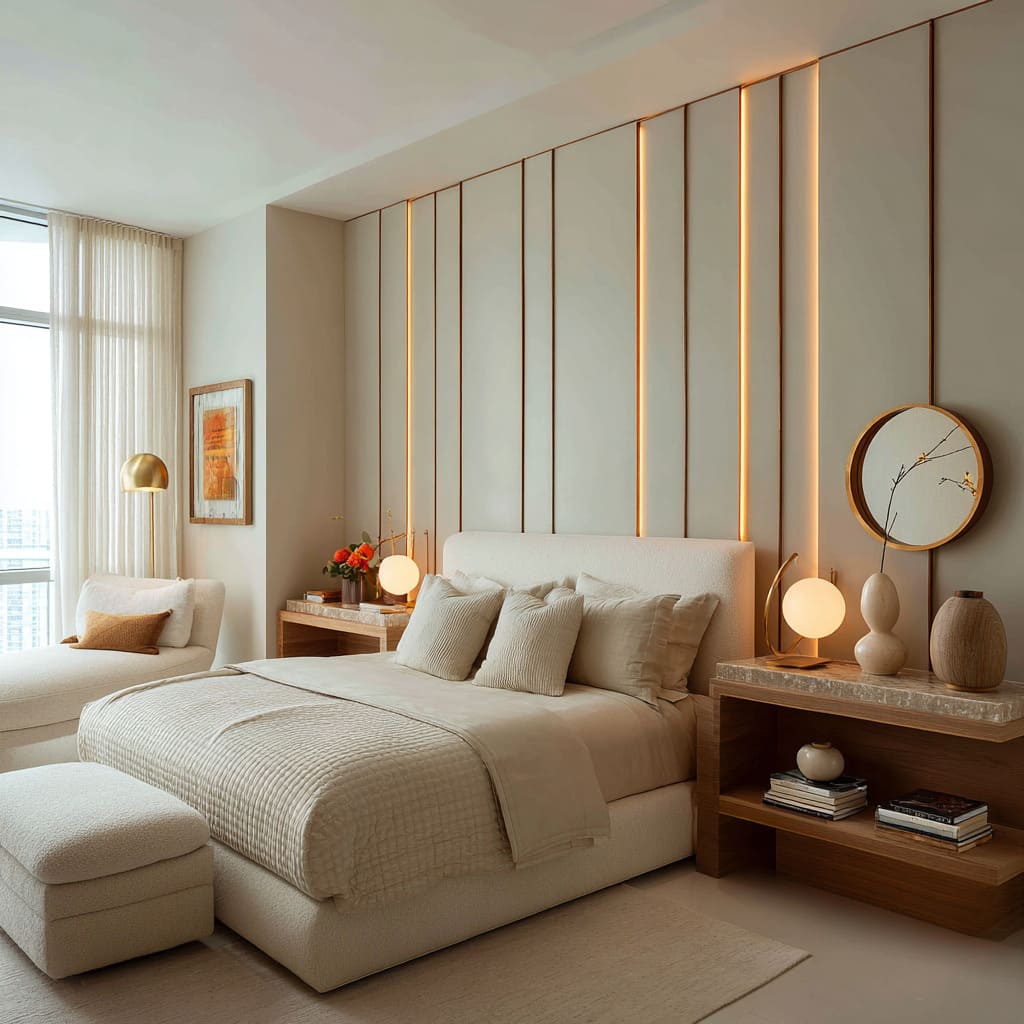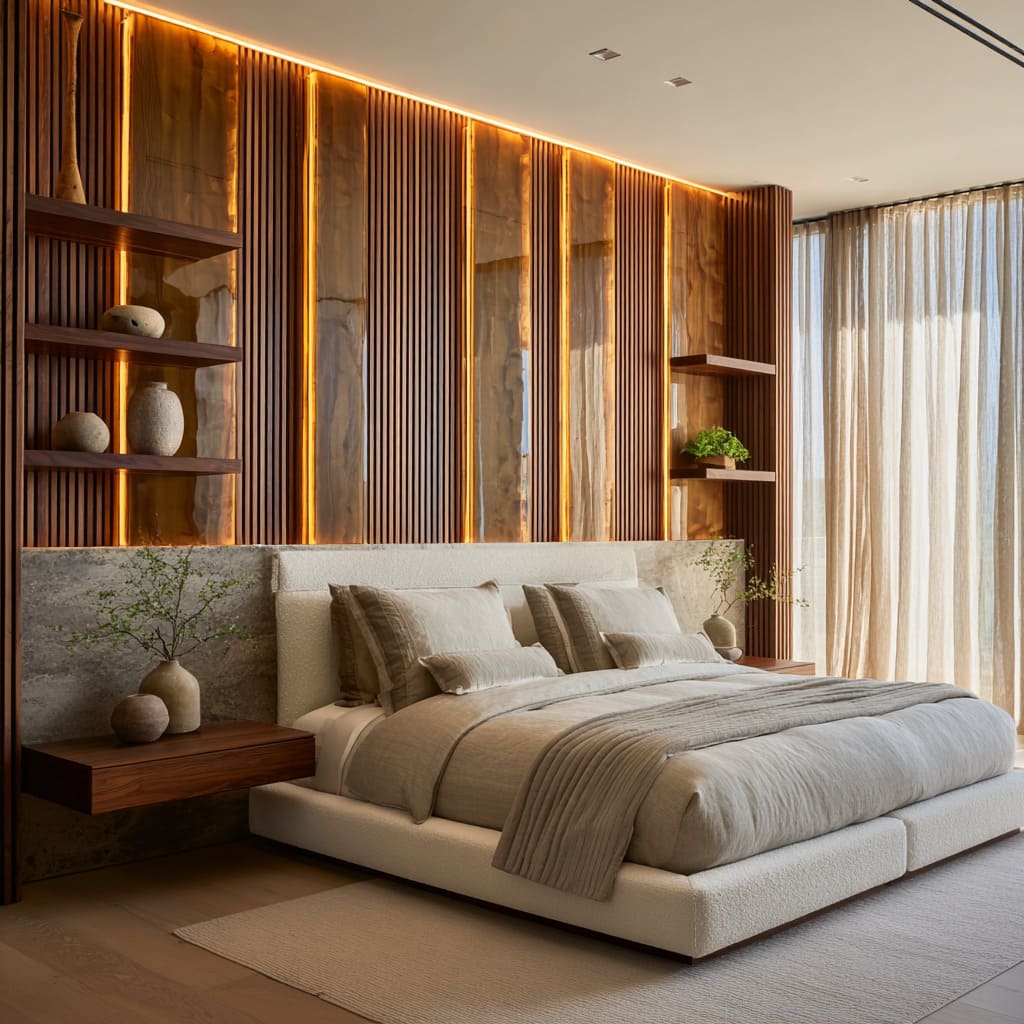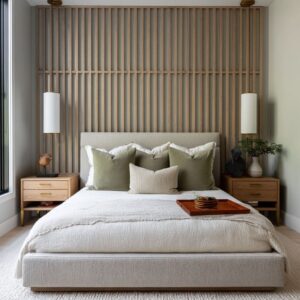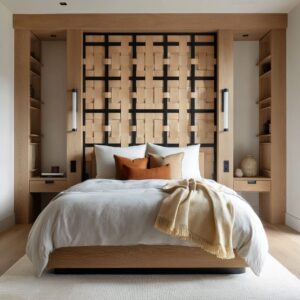In bedroom designs, the headboard wall behaves less like decoration and more like a gentle architectural structure built inside the room. Tall padded grids, stone panels, or timber slats run from floor to ceiling and sometimes fold onto the ceiling plane, so the wall feels deep and intentional instead of flat.
The bed is not pushed against a random surface; it is placed inside a prepared “field” of lines, seams, and textures that surround it quietly. Vertical seams in grey panels, bronze trims between soft stone rectangles, or honey oak ribs set in front of a white shell all work like subtle columns.
They give the impression that the bed is housed inside a niche, capsule, or pavilion, even when the plan is perfectly simple. Within this language, modern luxury bedroom ideas often use just three or four ingredients—neutral textiles, structured panel layouts, and controlled lighting—to generate a surprisingly rich sense of architecture without adding physical bulk.
The feature wall becomes a kind of built-in furniture element that sets the tone for everything else: the nightstands grow from it, the pendants relate to it, and even the rug shape and floorboard direction quietly respond to its rhythm.
Grid-Based Walls
Where the feature wall is organized as a grid, the room feels like a calm gallery box lined with padded or stone “tiles” that have been drawn over with fine metal lines. Large rectangles stack vertically and horizontally, yet the pattern is almost always slightly irregular: a bronze line stops short of the ceiling, a horizontal band changes length, or panel joints line up with bed and nightstand edges instead of forming a strict matrix.
This small amount of irregularity is important; it keeps the grid from looking like office partitioning and shifts it into the world of abstract art. In the context of modern luxury bedroom design, this kind of grid wall replaces the classic idea of a painting above the headboard.
The wall itself becomes the artwork: bronze trims act like drawn lines, the panels behave like a canvas, and the hidden light at edges or between seams becomes the glowing backdrop. The bed responds by staying low and blocky, with a headboard that quietly repeats the panel size or proportion so that furniture and wall speak one language.
Benches at the foot, often in cognac or soft rust leather, act as a warm horizontal brushstroke inside this structured surface, linking the wall’s metal tones to the bedding and floor.
Slatted Backdrops and Timber Pavilions
In another group of rooms, timber slats take over from metal grids and padded panels. Narrow wood ribs run in tall stripes behind the bed, sometimes stopping at the ceiling line, sometimes turning that corner and continuing overhead to form a light canopy.
This creates a feeling that the bed sits inside a small architectural pavilion—a timber “box” hovering inside an otherwise plain shell. In some spaces the wood is pale and breezy, suggesting coastal or Nordic influences; in others it is deep and saturated, paired with strong sunlight and terracotta textiles for a dry-climate or desert mood.
The pattern is careful: slats rarely cover every wall. They form a controlled insert that is wider than the bed but narrower than the room, framed by painted surfaces, mirrors, or stone.
In a luxury modern master bedroom design that uses slats in this way, the ceiling becomes just as important as the wall: beams align with vertical fields, canopy bands match the bed width, and underlighting or top-edge lighting reinforces the impression of a three-sided timber shell. The rest of the room stays beautifully restrained, with simple boxy nightstands, low platforms, and linens that echo the grain tone without competing with it.
Light as Drawing
Light in such bedroom designs behaves like a drawing tool, replacing heavy color accents with slim luminous strokes. Vertical light slots appear at the edges of panel fields or between stone slabs, washing the sides in warm amber so the wall looks thicker and more sculpted than it really is.
A thin line of light runs along the top of an upholstered grid and pours downward, brightest near the ceiling and fading toward the headboard, making the surface look subtly taller and slightly curved. Under some beds a continuous strip glows along the base, so the timber platform looks as if it hovers just above the rug; the same tone repeats at the top of a slatted wall, forming a soft rectangular “container” of light that surrounds the sleep zone.
Small light sources are handled with the same discipline: clear glass globes that sit like fireflies near the nightstand level, tubular pendants that act almost like vertical candles, or orb lamps resting on stone-topped consoles that mirror the spherical forms of the moon. Within this system of linear seams and small glowing objects, luxury modern bedroom ideas often treat sunlight as another pattern layer: diagonal shadows from exterior beams cut through vertical slats, or late-afternoon stripes graze stacked stone and linen, turning the daytime room into a slow-moving graphic composition that changes with the hour.
The Bed as Sculptural Comfort Block
The bed in such concepts carries a very particular role: it is the only large object allowed to be fully soft, and its form is tuned carefully to the geometry behind it. When the wall is strict and rectilinear—bronze-framed fabric grids or large stone rectangles—the bed often gains rounded corners, a curved base, or circular side tables, so arcs and circles gently soften the rectilinear backdrop.
When the wall is more natural and irregular—stacked stone blocks, heavily grained timber—the bed usually takes a simpler tray-like shape, almost like a floating platform with thick linen piled on top.
In both cases, the bed reads as a single, substantial “comfort block”: rug, platform, mattress, duvet, and pillow stack build a stepped mass that contrasts with the vertical emphasis of the wall. Nightstands follow this logic.
Many are floating boxes or integrated ledges that do not touch the floor, so they keep the heavy wall language but feel lighter, while benches at the foot tend to hover on inset legs so that they introduce deep color without visual weight. These compositions support luxury modern master bedroom interior design where comfort looks sculptural: the bed is low and generous, the textiles layered but monochrome, and the body feels visually invited into a landscape of softness framed by strong architectural lines.
Fabric, Timber, and Stone as Distinct “Worlds”
The same slat and grid logic shifts character dramatically depending on the dominant material story. Fabric grids in soft greys, stone tones, or creamy shades create a tailored, city-hotel mood: panels look like suede or velvet, bronze seams read like fine stitching, and the entire wall behaves like a giant headboard with quiet couture references.
Timber slats, whether pale or dark, speak of crafted joinery and carpentry: the wall becomes a piece of built-in furniture where shelves are not added separately but grow out of the ribbed surface, and the ceiling beams above answer the stripes behind the bed.
Stone fields bring in a different world again: large blocks or panels arranged in quiet rhythms evoke cliffs and rock faces, especially when a linear fireplace cuts a horizontal opening through the mass or when daylight grazes the edges of each block and picks up texture. These three families—soft grids, timber slats, stone compositions—can be mixed gently, but each one leads the narrative of the room.
In some schemes the bed sits against fabric and within a timber U-frame; in others it slips into a stone pocket with a wood floor and linen blankets, aligning with wider luxury modern bedroom ideas where the architectural surface, not color, defines the emotional tone.
The Bedroom as Micro-Living Space
Another key theme running through these concepts is the way the master bedroom behaves like a small private living room as well as a sleeping area. The feature wall often stretches beyond the bed to include built-in shelving and console zones, especially in rooms where a backlit stone panel forms the backdrop for slim wooden shelves and fluted cabinet doors.
Objects on those shelves are curated rather than stored: rounded ceramics, framed art, woven pieces, and dried branches are spaced deliberately with plenty of emptiness in between, so each item relates to the grid or slat rhythm instead of fighting it.
A lounge element joins the composition—a bouclé armchair with a low base plate, a chaise stretched toward a window, or a reading chair positioned near the shelves and a tiny marble side table. Floor lamps or low pendants support these corners with gentle light, tying their glow back to the vertical wall seams behind the bed.
In cooler rooms with fabric grids the effect leans toward boutique hotel suite; in warmer timber and stone settings it feels closer to a lodge or retreat. Either way, luxury modern master bedroom design often weaves together sleeping, reading, and quiet display into one continuous visual story along a single wall.
Hidden Compositional Rules
Behind the apparent simplicity of such interiors, several quiet rules repeat and hold the spaces together. The feature wall almost never stops exactly at the width of the bed; it extends beyond the nightstands so the bed sits inside a generous band rather than pressed to its edges.
Vertical elements, whether slats, metal trims, or lighting bars, usually line up with something tangible: the width of a nightstand, the position of a pendant, the centerline of cushion stacks, or the edge of a bench. Horizontal elements answer them: shelves align to the top of the mattress or the base of the headboard, consoles behind the bed pick up the thickness of the platform, rug edges echo the outer limit of nightstands rather than the bed alone.
Texture layering follows a similar discipline. In a single palette of creams or sand, surfaces alternate between ribbed and smooth, matte and slight sheen, coarse linen and tight weave, so the room feels rich without breaking the color harmony.
Even color accents follow a connecting rule: a rust pillow speaks to bronze trims, a terracotta throw nods to timber warmth and imagined exterior earth tones, a muted yellow cushion picks up the straw of baskets and dried grasses on nearby shelves. In this way, the slat and grid feature wall is not a standalone move; it is the underlying grid from which every other decision quietly takes its measure.
Conclusion
Taken together, these concepts sketch a clear language for luxury modern master bedroom ideas that rely on slat and grid feature walls. The room is not driven by bold color or busy pattern but by alignment, repetition, and touchable surfaces.
The headboard wall functions as an architectural insert inside a simple shell, whether it appears as padded rectangles stitched with metal, timber ribs that rise and turn onto the ceiling, or stone panels with light slid between them. The bed stays low and substantial, the textiles are thick and usually neutral, and comfort looks intentional rather than casual.
Light draws lines and frames zones, from under-bed strips to edge glows and tall sconces that behave like luminous posts. Storage and display are absorbed into the wall system through floating nightstands, built-in shelves, and consoles set in front of stone or slatted fields.
A chair, chaise, or small sitting corner often completes the picture, hinting at late-night reading, morning coffee, or quiet time with an open window. The result is a family of rooms where minimalism feels generous, and where slats and grids form a shared structure that can support many moods—from soft city glamour to warm timber cocoon or carved-stone retreat—without ever losing the calm, modern, and quietly luxurious character at the heart of the style.
